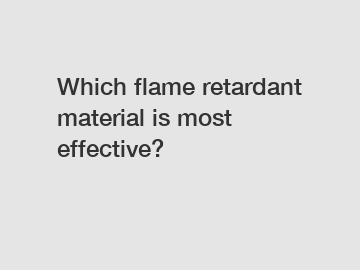Which flame retardant material is most effective?
Which flame retardant material is most effective? When it comes to protecting against fire hazards, the answer lies in the use of halogen-free flame retardants. These materials have proven to be highly effective in preventing and slowing down the spread of flames, making them an essential component in a wide range of applications, from textiles to electronics. In this article, we will explore the reasons behind their effectiveness, their significance in fire safety, and the impact they have on various industries.
Halogen-free flame retardants are a group of chemicals that are specifically designed to inhibit or suppress the combustion process. Unlike their halogenated counterparts, which contain elements such as chlorine and bromine, halogen-free flame retardants do not release toxic gases when exposed to heat or flame. Instead, they work by forming a protective layer over the material, preventing the combustion process from occurring.
The effectiveness of halogen-free flame retardants can be attributed to their unique chemical properties. These materials have a high heat resistance, allowing them to withstand extreme temperatures without degrading. This property is crucial in preventing the spread of fire, as it buy precious time for people to evacuate a building and for firefighters to arrive at the scene. Additionally, halogen-free flame retardants have a low smoke density, reducing the amount of smoke released during a fire. This is beneficial for visibility and improving the chances of a successful evacuation.

Furthermore, the absence of toxic gases emitted by halogen-free flame retardants makes them a safer choice for both human health and the environment. Halogenated flame retardants have been found to release toxic substances when burned, posing serious health risks to both occupants and firefighters. The use of halogen-free alternatives eliminates these hazards, providing a safer environment for everyone involved.
The significance of halogen-free flame retardants in fire safety cannot be overstated. In addition to protecting human lives, these materials also help to minimize property damage and economic losses caused by fires. By slowing down the spread of flames and reducing the release of toxic gases, halogen-free flame retardants give firefighters a better chance of extinguishing the fire before it becomes uncontrollable. This, in turn, leads to reduced damage to structures and valuable assets.
In various industries, the use of halogen-free flame retardants is mandated by strict regulations and standards. For example, the textile industry requires flame retardant fabrics to meet specific safety requirements. Similarly, the electronics industry relies on these materials to protect sensitive components from heat and fire. The effectiveness of halogen-free flame retardants has made them a preferred choice in these industries, ensuring compliance with safety regulations and providing peace of mind to manufacturers and end-users.
In conclusion, the most effective flame retardant material is undoubtedly the halogen-free variety. Its ability to prevent and slow down the spread of flames, combined with its non-toxic nature and high heat resistance, sets it apart from its halogenated counterparts. The use of halogen-free flame retardants is not only essential for protecting lives and minimizing property damage, but it also contributes to a safer and more sustainable environment.
Want more information on fireproofing fabric, Flame Resistant Fabric By The Yard, flame resistant fabrics? Feel free to contact us.


